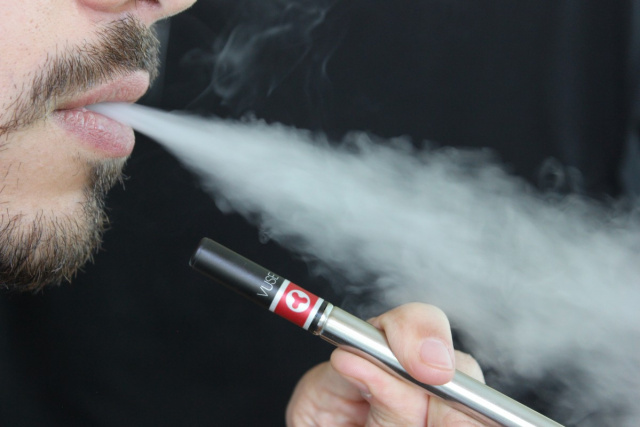(COLUMBUS, Ohio)—Ohio Governor Mike DeWine today announced that as a result of increasing pulmonary complications caused by vaping, he is announcing a long-term effort to curb youth vaping and supporting a legislative push to ban flavored e-cigarette products.
“We have two separate, but related problems in connection to vaping. First, we are facing deaths and very serious medical problems caused by vaping, the second problem is the dramatic increase in youth vaping – 135% increase in high school students vaping since 2017 alone,” said Governor Mike DeWine. “We must take necessary steps to protect Ohio’s young people from the cycle of addiction.”
According to the Centers for Disease Control and Prevention (CDC), 12 people have died nationwide due to vaping-related severe lung disease. As of this morning, the Ohio Department of Health has identified 22 cases, including one involving a 15-year-old, and is investigating 19 additional cases.
To protect young people from the dangers of vaping, Governor DeWine had requested his administration review Ohio law as it relates to a statewide ban on flavored e-cigarette products. The DeWine Administration determined that the best course of action is to partner with the General Assembly to work to ban flavored vaping liquid, including menthol and mint.
In addition, Governor DeWine announced that he will be sending a letter to the Food and Drug Administration asking them to take swift action to draft and adopt rules to promptly ban flavored e-cigarette products.
Building upon outreach efforts by the Ohio Department of Health to school superintendents, Governor DeWine will also send letters to all Ohio college and university presidents asking them to enhance their smoke-free campus policies, including rules on vaping.
The actions announced today are part of a larger effort Governor DeWine and the General Assembly have taken to reduce vaping among young people. As part of the biennial budget, the sale of tobacco and vaping products to anyone under 21 is banned beginning October 17th, 90 days after the budget was signed into law. As a result of teen smoking, three out of four teen smokers continue to smoke into adulthood. The 18-to-21 age range is the time when many smokers transition to regular, daily smoking.
Today, a tax on vaping products included in the biennial budget went into effect. This tax charges distributors 10 cents per milliliter of vaping products. Raising the price of cigarettes has been one of the most effective ways to reduce smoking rates.
On Friday, the CDC issued an updated alert on the “Outbreak of Lung Injury Associated with E-Cigarette Use, or Vaping,” as part of its ongoing investigations in severe lung illnesses and deaths related to vaping. Specifically, the alert states that “While this investigation is ongoing, the CDC recommends that you consider refraining from using e-cigarette, or vaping, products, particularly those containing THC.”
As a result, the administration took the following actions:
- The Ohio Department of Health updates its directive, now requiring, rather than suggesting, that vaping-related illnesses be reported to them.
- The Ohio Department of Commerce issued an alert to its medical marijuana licensees to make them aware of the CDC message and to let them know that the Medical Marijuana Control Program protocols might be amended, including a ban on ingredients or products found to be unsafe. The department suggested that licensees consider producing alternative products that don’t involve vaping.
- The Ohio Board of Pharmacy just sent an alert to all medical marijuana patients about the CDC message. The board announced that it received 30 reports of adverse events regarding medical marijuana, including six related to vaping products.
Background:
Since 2017, there has been a 135% increase in e-cigarette use among high schoolers. This increase has been largely driven by flavored vaping liquid sales. Last year, 75.5% of high school e-cigarette users said they vaped with fruit-flavored liquid, 51.2% said they vaped with menthol or mint, and 46.2% said they used candy-flavored liquid. In fact, most kids don’t even realize what they are vaping contains nicotine. In 2018, found that 63% of 15 to 24-year-old JUUL users, JUUL being one of the leading vaping products – did not know that the product always contains nicotine. Some JUUL cartridges, or pods, have the equivalent amount of nicotine as an entire pack of cigarettes.
Nicotine in adolescence can harm the parts of the brain that control attention, learning mood, and impulse control. We know that nicotine affects the way a young person’s brain functions. The Ohio Department of Mental Health and Addiction Services reports that young people who consistently smoke throughout adolescence are at significantly great risks for use of alcohol, marijuana and abuse or dependence on other drugs. Research links smoking in adolescents to earlier onset and more episodes of major depressive disorder, anxiety disorders, and other mental health challenges.
For those looking to quit smoking, they can contact the Ohio Tobacco Quit Line (1-800-QUIT-NOW) for counseling. For those that have questions about medical marijuana and vaping, they can contact the Ohio Medical Marijuana Control Program Toll-Free Helpline at 1-833-464-6627.










